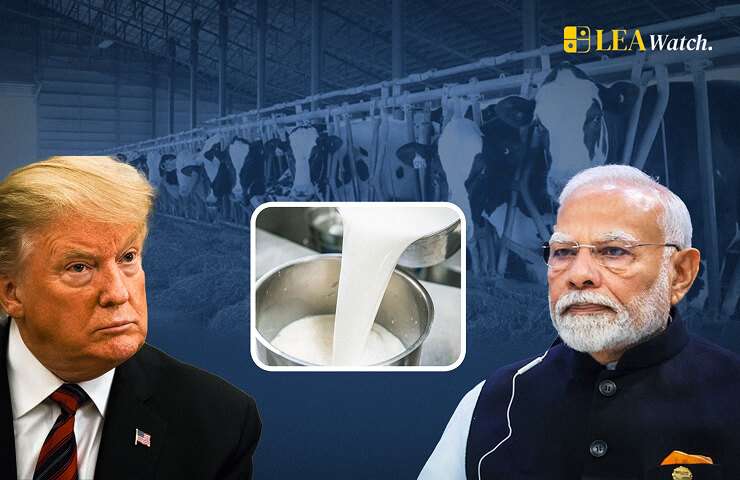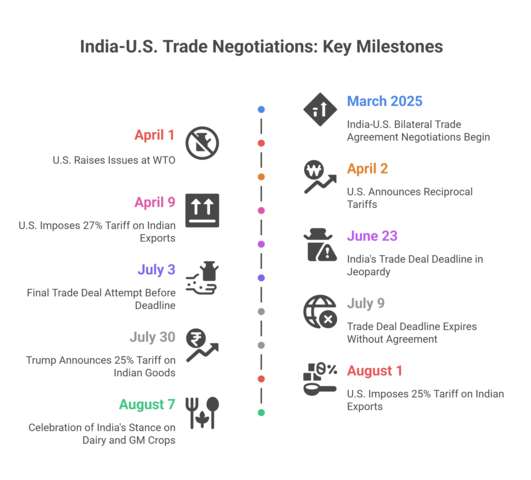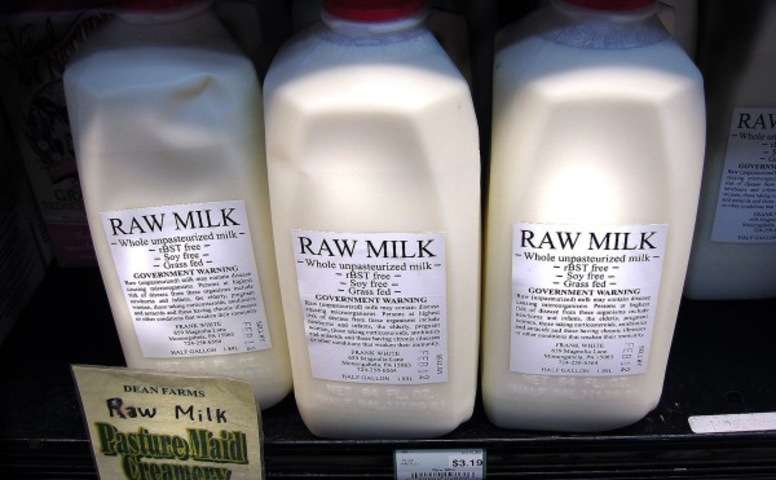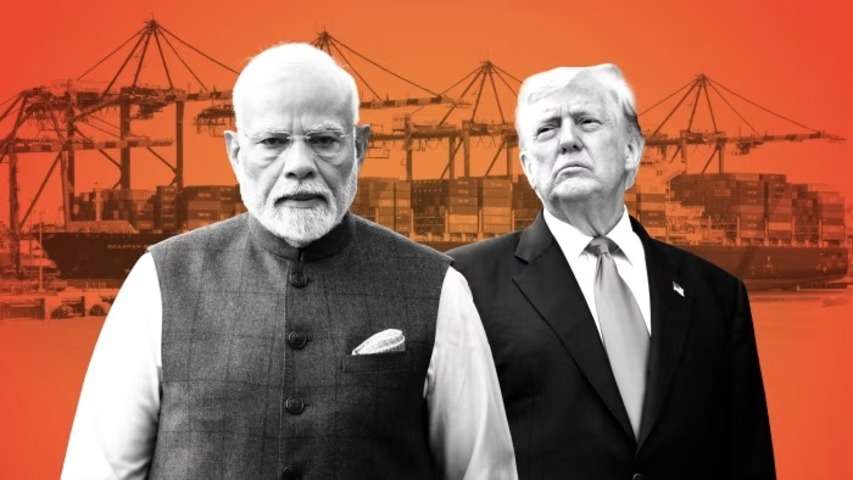In 2025, India-U.S. trade relations hit new lows due to several conflicts such as the non-veg milk controversy, as well as existing dairy disputes. The American offer to access the Indian market with trade of milk products, especially those manufactured from cows that are fed animal by-products, creates conflict with India’s economic and religious concerns of safeguarding the 80 million smallholder dairy farmers alongside Hindu sentiments on milk purity. As a result, in the face of stagnant trade negotiations, the U.S. imposed a 25% import duty on almost all Indian exports with the condition of agricultural tariff revisions, India’s stance on Russia, and the previous tariff dispute. The timeline in question showcases pivotal events from the non-veg milk controversy to the steep tariff increases in the backdrop of the trade negotiations.
Timeline
- India-U.S. Bilateral Trade Agreement (BTA) Negotiations Begin: India and the U.S. announce the start of BTA negotiations with the intent to double bilateral trade to $500 billion by 2030 from $191 billion currently. The U.S. is advocating for market access for India’s agricultural products including dairy, genetically modified (GM) crops and other products like apples, almonds, and ethanol. India does not support lowering tariffs on dairy products, rice, wheat, and GM crops and is arguing that it views the livelihood of 700 million rural citizens, including 80 million smallholder dairy farmers, as a significant issue.
- U.S. Raises Issues at WTO: The U.S. criticized India’s restriction on dairy imports including the requirement for that veterinary certification stating that dairy products are from cows that were not fed any animal by-products, calling it a trade barrier.
- India’s National Program for Dairy Development (NPDD) Revised: India’s Ministry of Fisheries, Animal Husbandry and Dairying announces a $37 million allocation for the 2025/26 budget to develop dairy infrastructure, broader milk procurement, and improve quality control demonstrating India’s commitment to its dairy industry.
April 2025
- April 1: The U.S. Trade Representative released the National Trade Estimate (NTE) Report noting high tariffs (e.g. 150% on alcoholic beverages, 100% on walnuts and raisins) and trade restrictions on dairy imports (including a ban on items from cows fed animal by-products), as the most significant trade barriers to the U.S. market. Indian representatives defended these trade barriers as complying with domestic cultural and religious needs.
- April 2: U.S. President Donald Trump announced reciprocal tariffs between 11% and 49% on 60 countries from April 9, 2019. It includes India as part of a tariff inspired by India’s dairy and agricultural roots. In response India is temporarily refraining from retaliatory measures and adopting a wait-and-see approach to evaluate the situation.
- April 9: The U.S. announced it would impose a 27% tariff on some of Indian exports that are less than those imposed on competitors such as China (which are as high as 54%). India’s dairy sector (e.g. exporters of milk-products such as paneer and ghee) may face challenges and international trade opportunities that may arise from changing trade flows.
June 2025
- June 23: India’s ability to finalize a trade deal with the U.S. as of July 9 is in jeopardy especially when dairy are sensitive issues because of India’s emphasis on the sensitivity of agriculture and dairy issues. Indian officials have stated that, if the deadline is missed, it will revert back to April 2 tariff levels.
- June: Finance Minister Nirmala Sitharaman touts agriculture and dairy are “very big red lines” in discussions of trade agreements, referring to cultural, dietary, and religious sensitivities around cow dairy imports related to cows fed animal by-products.
July 2025
- July 3: U.S. and Indian negotiators attempt to finalize a trade deal before Trump’s deadline on July 9, but there are still issues countering progress on dairy and agriculture talks. The major issue remained India’s insistence on certifying U.S. dairy as non-veg, which is linked to religious and cultural beliefs of Hinduism relating to milk purity.
- July 7-9: Indian external affairs minister S. Jaishankar visits D.C. to meet with U.S. Secretary of State Marco Rubio to strike an interim deal. India cemented its position on protecting its dairy industry and made it clear that the non-veg milk issue (this relates to feed fed to U.S. dairy cows that are animal by-products like blood meal and bone powder) represented a “non-negotiable red line.”
- July 9: The deadline for Trump’s talks expires without a trade deal. The non-veg milk saga along with India’s intransigence on GM crops and agricultural market access had hampered negotiations. India’s very high tariffs 30% cheese, 40% butter and 60% powder milk as well as the veterinary checks blocked U.S. dairy products from entering India.
- July 15: India Today reports that non-veg milk issues are at the center of the trade impasse with India due to India’s insistence of stringent certification to confirming U.S. dairy is vegetarian-based feed. This is representative of the cultural significance of milk being used in a variety of rituals performed by Hindus and milk being viewed as a pure item.
- July 16: A report, from the State Bank of India (SBI), included an estimate that opening India’s dairy sector to U.S. dairy imports could result in an annual loss of ₹1.03 lakh crore due to a guaranteed 15% drop in domestic milk prices. Eighty million smallholder dairy farmers are at risk.
- July 17: India Today produced a YouTube news highlight video about non-veg milk which may be another roadblock, further emphasizing India’s cultural and religious sensitivities.
- July 18: Investment banker Sarthak Ahuja, shares the non-veg milk topic through a LinkedIn post, explaining that U.S. dairy cows are fed animal by-products which makes the milk unacceptable for India’s vegetarian population (30% population). The case could generate wider public interest in the non-veg milk controversy.
- July 30: Former Commerce Minister Suresh Prabhu emphasizes on X that India’s dairy sector supports over 600 million people, not as a tool for trade deals. He calls for fair negotiations that honor India’s rural foundation.
- July 30: Trump announces a 25% tariff on Indian goods, starting August 1. He cites India’s high tariffs, non-tariff barriers, and connections with Russia. The non-veg milk issue, along with India’s refusal to import GM crops and open agricultural markets, is a major reason for the tariff increase. Indian officials and posts on X point out that this tariff rise follows India’s strong position on dairy and agriculture.
- July 31: India promises to safeguard its agriculture and dairy sectors. Officials estimate the impact on GDP will be less than 0.2% from the 25% U.S. tariff. The opposition criticizes the government, and the rupee drops. India plans to restart talks in mid-August.
August 2025
- August 1: The U.S. imposes a 25% tariff on almost all Indian exports. This is a big jump from the previous 0-10% rates on different product categories. This action follows the failure to settle the non-veg milk issue and other agricultural conflicts. The tariff is also linked to India’s ongoing purchase of Russian oil and defence equipment.
- August 2: India takes a firmer stance. It refuses to cut tariffs on dairy, GM foods, and other agricultural products. The Economic Times reports that five rounds of BTA talks have happened, with the next round set for August 25. U.S. Assistant Trade Representative Brendan Lynch will lead this round.
- August 6: A Chinese scholar, Wang Se, says that the special status of milk in India, which is connected to Hindu rituals and identity, was a major reason for the failure of the trade talks. The non-veg milk issue, especially concerning the diets of U.S. dairy cows that include blood meal and bone powder, conflicts with India’s religious beliefs. This makes dairy imports politically difficult for the Modi government.
- August 7: Posts on X say that India and the U.S. almost reached a trade deal in early July. However, discussions stalled due to dairy products, especially the non-veg milk issue, and GM crops. Some celebrate India’s refusal to compromise on these matters as a way to protect farmers and cultural values.
Key Issues in the Non-Veg Milk Controversy
Cultural and Religious Sensitivities regarding Hindu customs, dairy holds considerable respect and significance, which makes feeding cows vegetarian diets essential. For this reason, U.S. dairy cows pose a problem since they are often fed animal by-products like bone powder and blood meal. This is a problem for a significant percentage of Indian consumers, especially the 30% of the population that are vegetarians. There is also the issue of sufficing Indian standards for dairy certification which the U.S. sees as a trade impediment. Economic Impact India now has a newly adopted dairy sector which accounts for a 2 and a half percent increase in GDP, remitting 7.5-9 lakh crore. Alongside this, the dairy sector also consists of around 80 million smallholder farmers. There is a threat for smallholder farmers due to the new U.S. subsidized dairy as it is predicted that the price will drop by 15 percent. This will incur a loss of about 1.03 lakh crore annually putting people in rural areas at risk for loss of employment. While these two countries come to the negotiating table about dairy, India has set a price of 30% for cheese, 40% for butter, and 60% for milk powder. While these terms may look disadvantageous to India, they are meant to be a form of self-defensiveness.
Tariff Escalation Post-Non-Veg Milk Controversy
The U.S. placed tariffs on Indian goods before July 2025 at 0-10% rates which included 50% duties on steel and aluminum as well as 25% on autos. The 27% tariff against particular Indian products started on April 9 2025 as the U.S. implemented its extensive tariff approach that covered 60 nations. The non-veg milk controversy had not yet gained widespread attention but this situation created conditions for future trade disagreements. The U.S. established a complete 25% tariff on most Indian exports starting August 1 after trade negotiations broke down because of the non-veg milk controversy and India’s dairy and agricultural market restrictions. The new 25% tariff represents a major increase from previous variable tariff rates and serves as a reaction to India’s high tariffs together with non-tariff barriers and its strategic relationship with Russia. The 25% tariff applies to almost $40 billion of Indian export products yet the majority of exports remain free from this impact because of pre-existing exemptions. India expects its GDP to decrease by under 0.2% because of this situation and will implement domestic support programs which include lowered testing costs for small exporters and employment-based export assistance programs.
Broader Context
The Indian government focuses on protecting its rural population which includes 80 million dairy farmers through high tariffs that average 39% on agricultural goods and reach 65% on certain critical imports. The non-veg milk controversy serves as a demonstration of India’s independent strategic approach to U.S. influence since America provides $61,000 per farmer in agricultural subsidies compared to Indian subsidies of only $282. U.S. Demands The U.S. demands tariff elimination for dairy products and GM crops and ethanol and wants simplified customs regulations as well as data storage rules and patent laws. India stands against U.S. demands especially regarding dairy and GM crops thus blocking the path to a “fair” trade deal. Geopolitical Factors The trade conflict between the United States and India stems from U.S. tariffs which relate to India’s energy and defence partnerships with Russia thus creating a strategic element in the dispute. Some analysts interpret India’s decision to resist U.S. pressure as a move to protect its own national interests.
Conclusion
In 2025, trade issues between India and the U.S. showed just how tricky it is to match up two farm economies that are worlds apart. The U.S. wanted to sell more stuff in India, but India was all about protecting its small dairy farmers, culture, and making sure everyone has enough to eat. The whole non-veg milk thing, which was all about religious beliefs and what people eat, became a real problem. It just goes to show how things other than money can change how countries trade. India didn’t want to cut tariffs on dairy, which helped keep its rural areas going, but it made the U.S. mad. So, the U.S. cranked up tariffs by 25%. Even though things got a little messed up for a while, India’s actions showed they’re serious about taking care of themselves and helping their farmers. If they want to move forward, both countries need to find a middle ground. They need to respect what India needs at home while taking care of the U.S.’s worries about trade. This problem shows that fair trade means giving and taking, but not if it hurts a country’s most important money-making and cultural stuff.




